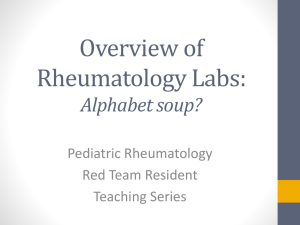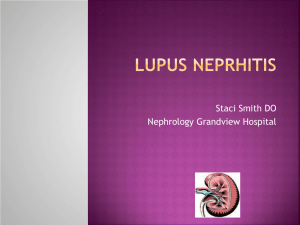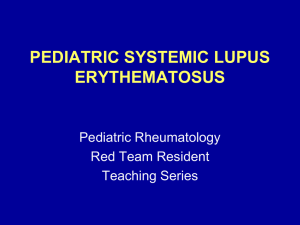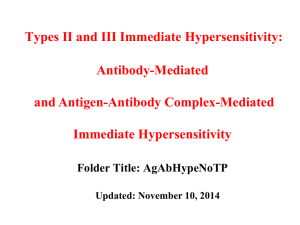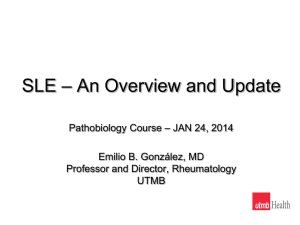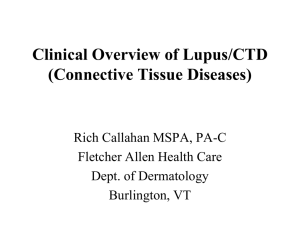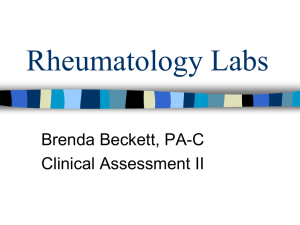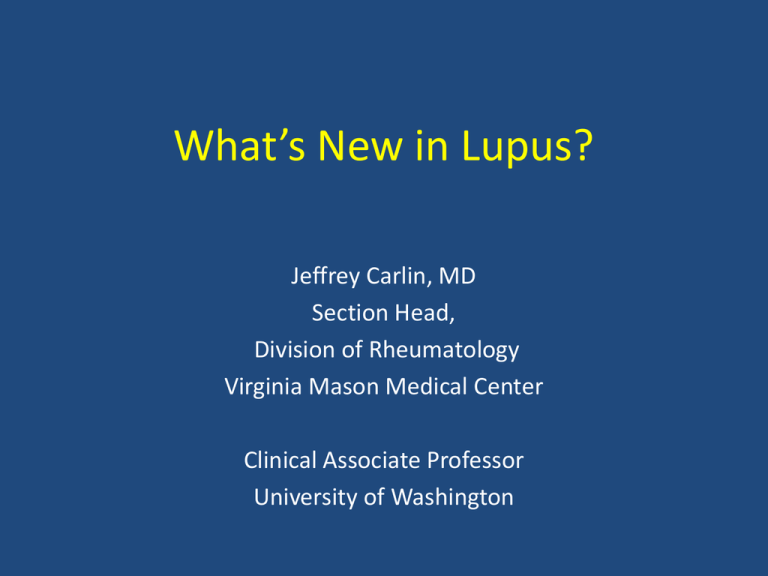
What’s New in Lupus?
Jeffrey Carlin, MD
Section Head,
Division of Rheumatology
Virginia Mason Medical Center
Clinical Associate Professor
University of Washington
Key Points
• Diagnosing Lupus
– ANA testing
• Treatment Options
• New Therapeutic Agents
• Adjuvant Therapy
Lupus Demographics
Incidence and Prevalence of SLE:
USA
(per
100,000
per year)
(per 100,000)
All
5.1
52.2
White
1.4
7.4
Black
4.5
19.5
Puerto 2.2
Rican
18.0
Rochester, MN
Uramoto KM et al Arth Rheum 1999;46-50
Incidence Prevalence
Danchenko N et al Lupus 2006:308-318
SLE - Etiology
• The etiology of SLE remains unknown
• Yet, SLE is clearly multifactorial:
EBV?
– Genetic factors
– Immunologic factors
– Hormonal factors
– Environmental factors
Genetic predisposition
Baseline immunological abnormalities
Infection
Hormonal factors
Abnormal (control of) immune responses
SLE
Interferon-α Stimulation
Ronneblom L, Alm GV Arth Res Ther 2003;68-75
Evironmental Triggers of SLE
•
•
•
•
UV Light
Drugs (>100 Identified)
Smoking
Infections
– Pet Dogs
– Lab workers
– EBV
• Silica
• Mercury
When Does Lupus Begin?
Arbuckle M, et al NEJM 2003
Stages in Development of Pathogenic
Autoimmunity
ANA Techniques
Frequencies of Positive ANA’s in
Normal individuals
Pooled ANA Data
Hep-2 Cell Lines
80
70
68.3
Percentage
60
50
40
31.7
30
20
13.3
10
5
3.3
0
Negative
1:40
1:80
1:160
Fluorescence/Dilution Level
1:320
Tan E.M., et al Arthritis and Rheum 1997
Estimated Prevalence of ANA +
in the US Population
Satoh M et al Arth & Rheum 2012;64:2319-2127
Positive ANA
High Probability
of
CTD
Identify
Specific
ANA Antigen
Consider
Ancillary
Lab Tests
Search for Other
Evidence of Disease
Or Organ Involvement
Low Probability
of
CTD
Low Titer
ANA
High Titer
ANA
Identify
Specific
Antigen
Reassure
Pt
Follow
Pt
Search for Other
Evidence of Disease
Or Organ Involvement
Remember!
A positive ANA does not mean the
patient has a connective tissue
disease, but a negative ANA will R/O
CTD
Lab investigations
• Screen- CBC, urinanalysis & serum creatinine
• Anti ds DNA
•
•
•
•
In about 60% with SLE
Levels often reflect disease activity
with Rx ( ANA remains +)
If normal – safe to Rx in chronic phase
• ENA’s
• complement
• In ¾ untreated esp. with nephritis
• APLA
In 1/3 to ½
Associated with renal arterial, venous & glomerular thrombosis
Anti-Ds DNA Antibody
Anti- Histone Antibody
Antibodies directed
against exposed
parts of the
Nucleosome
Anti-ds DNA Antibodies
• Large literature suggesting these are strong
biomarkers
• Used widely in clinical practice
– High Titer IgG anti-dsDNA predict nephritis
• But not in immediate future!
– High Affinity anti-dsDNA associated with flare
– Glomerular IC enriched for anti-dsDNA
Extractable Nuclear Antigens
(ENA’S)
• Autoantibodies against nuclear
ribonucleoproteins/nuclear components
– SSA, SSB, Sm, RNP, anti-Histone
• ELISA assays
• Useful for helping to confirm diagnosis
– used as adjunct to ANA
• Not useful for disease monitoring
– need not be repeated once identified
Anti-U1 SnRNP Antibodies
Anti-Sm Ab
Anti-RNP Ab
Prevalence of Autoantibodies in SLE
Antigen
SLE
Native DNA
Denatured DNA
Histones
SM Antigen
Nuclear RNP
Ribosomal RNP
SSA/Ro
SSB/La
40%
70%
70%
30%
30%
10%
35%
15%
DrugInduced
No
75-80%
>95%
No
No
No
No
Significance of Autoantibodies in SLE
Antigen
Native DNA
Denatured DNA
Histones
SM Antigen
Nuclear RNP
Ribosomal RNP
SSA/Ro
SSB/La
SLE
40%
70%
70%
30%
30%
10%
35%
15%
Clinical Associations
Nephritis (and flare)
Non-Specific
Drug-Induced Lupus
Severe SLE
Arthritis
SCLE, Sjogren’s NLS
SCLE, Sjogren’s NLS
Antibody Clustering in SLE
Hopkins Lupus Cohort Study -1,357 patients
Average follow-up 9.6 years
• Cluster 1 - anti-Sm/RNP Ab’s
– Primarily skin involvement
– Less proteinuria, anemia, thrombocytopenia
• Cluster 2 - anti-dsDNA/SSA/SSB Ab’s
– Highest incidence of renal disease
– Secondary Sjogren’s
• Cluster 3 -anti-dsDNA/LAC/ACL Ab’s
– Arterial/Venous thrombosus, livedo reticularis
– Highest incidence of CVA’s
To CH, Petri M Arthritis and Rheum 2005
ACR SLE Classification Criteria
(SOAP BRAIN MD)
1. Serositis:
(a) pleuritis, or
(b) pericarditis
2. Oral ulcers
3. Arthritis
4. Photosensitivity
10. Malar rash
11. Discoid rash
". ..A person shall be said to have SLE if
four or more of the 11 criteria are present,
serially or simultaneously, during any
interval of observation."
5. Blood/Hematologic disorder:
(a) hemolytic anemia or
(b) leukopenia of < 4.0 x 109
(c) lymphopenia of < 1.5 x 109
(d) thrombocytopenia < 100 X 109
6. Renal disorder:
(a) proteinuria > 0.5 gm/24 h or
3+ dipstick or
(b) cellular casts
7. Antinuclear antibody (positive ANA)
8. Immunologic disorders:
(a) raised anti-native DNA
antibody binding or
(b) anti-Sm antibody or
(c) positive anti-phospholipid
antibody work-up
9. Neurological disorder:
(a) seizures or
(b) psychosis
SLICC Criteria for Lupus
•
•
•
•
•
•
Acute Cutaneous
– Malar rash, subacute cutaneous
lupus rash, bullous lupus
Chronic Cutaneous
– Discoid Lupus, Lupus
panniculitis
Oral/Nasal Ulcers
Non-scarring Alopecia
Synovitis
Serositis
•
•
•
•
Petri M et al, Arth & Rheum 2012; 64: 2677–2686
Renal
– Urine protein/creat ratio >
500mg/24 hrs or active renal
sediment
Neuro
– Sz, pyschosis, myelitis,
mononeuritis, peripheral
neuropathy
Heme
– Hemolytic anemia,
neutropenia, lymphopenia
thrombocytopenia
Immunological
– ANA, DNA, Sm, Low
Complements, Coombs +,
Antiphospholipid Ab’s
Performance of SLICC Criteria
1997 ACR Criteria
2012 SLICC Criteria
Sensitivity
2907349 (83%)
340/349(97%)
Specificity
326/341 (96%)
288/341(84%)
74
62
Misclassified cases
Petri M et al, Arth & Rheum 2012; 64: 2677–2686
Clinical Features on Presentation in SLE
•
•
•
•
•
Arthritis or Arthralgia
Skin Involvement
Nephritis
Fever
Other
55%
20%
5%
5%
15%
Organ Involvement in the Course of SLE
– Joints
– Skin
• Rashes
– Discoid Lesions
– Alopecia
–
–
–
–
–
Pleurisy/Pericarditis
Kidney
Raynaud’s
Mucous Membranes
CNS (Seizures/Psychosis/CVA)
90%
70%
30%
40%
60%
50%
20%
15%
15%
50% Patients Have Organ Damage In the
Course of Disease
24.2%
15.0%
12.6%
11.7%
10.4%
10.1%
7.4%
7.4%
5.5%
6.1%
2.5%
1.2%
Musculoskeletal
Neuropsychiatric
Ocular
Renal
Pulmonary
Cardiovascular
Gastrointestinal
Skin
Peripheral Vascular
Diabetes Mellitus
Malignancy
Premature Gonadal Failure
Acute Cutaneous
Malar Rash- Note Sparing of Nasolabial Folds
Discoid Lupus
Chronic Cutaneous: Discoid
Note Scarring, Hyperpigmentation
Follicular Plugging
Which patient has SLE?
Subacute Cutaneous Lupus
Papular squamous
eruption
Annular eruption
Livedo Reticularis
Non-specific Skin Manifestations
Raynaud’s with tissue breakdown
Vasculitis
Joint Disease in SLE
Nodules Possible
Jaccoud’s Arthopathy:
Nonerosive, Reducible Deformities
Severe Hematologic Syndromes of SLE
DX
Antibodies
Clinical Features
APS
ACL, antiB2GP1,
LA
Thrombosis inflammation
ITP
anti-IIb/IIIa, PF4
Bleeding <20K
Thrombosis
Hemolytic
Anemia
Coomb’s +
Hemolysis
TTP
VWB multimer
protease
antibodies
Catastrophic APS
HELLP Syndrome
TTP of SLE
Bleeding
anti-FVIII
(IX, X!, XII, XIII)
Hematomas, Hematuria
GI/mucosal bleeds
Anti-Cardiolipin Antibody Syndrome
• Recurrent arterial or venous events
• Obstetrical
– Recurrent miscarriages/fetal growth retardation
• Thrombocytopenia
• Incidence of + Antibodies in SLE
– LAC -30%
– ACL- 23-27%
– Anti- B2 Glycoprotein 1 - 20%
• 2 + tests 12 weeks apart to confirm
diagnosis!
Lupus Nephritis
Class I: normal glomeruli (~8% of biopsies)
Class II: pure mesangial alterations (~40% of biopsies)
Class III: focal glomerulonephritis (~15% of biopsies)
Class IIIA: focal segmental glomerulonephritis (~12%
of biopsies)
Class IIIB: focal proliferative glomerulonephritis
Class IV: diffuse glomerulonephritis (~25% of biopsies)
Class V: diffuse membranous glomerulonephritis (~8% of
biopsies)
Class VI: advanced sclerosing glomerulonephritis
Prognosis in Lupus Nephritis
• Predictors of poor prognosis:
–
–
–
–
–
–
–
–
Black race
Male
Anemia
creatinine
Nephrotic range proteinuria
Glomerular & tubulointerstitial scarring
Severe tubulointerstitial nephritis
Chroniciy index > 3
ACR NOMENCLATURE AND
CASE DEFINITIONS FOR NEUROPSYCHIATRIC LUPUS SYNDROMES
Central nervous system
Aseptic meningitis
Cerebrovascular disease
Demyelinating syndrome
Headache (including migraine and benign intracranial hypertension)
Movement disorder (chorea)
Myelopathy
Seizure disorders
Acute confusional state
Anxiety disorder
Cognitive dysfunction
Mood disorder
Psychosis
ARTHRITIS & RHEUMATISM 1999, pp 599-608
Prevalence of 12 NP Clinical Syndromes in
CNS lupus (N=300)
•
•
•
•
•
•
•
•
•
•
•
•
Headache
CVA
Mood disorder
Cognitive dysfunction
Psychosis
Seizure disorder
Anxiety Disorder
Aseptic meningitis
Acute confusional state
Transverse myelopathy
Movement disorder
Demyelinating syndrome
24%
18%
17%
11%
8%
8%
7%
4%
4%
1%
1%
1%
Sanna G, et al Journal of Rheumatology 2003:30;985-992
•
•
•
•
•
•
•
•
Diagnostic Studies in CNS Lupus
CT
MRI
SPECT
PET
MRA
CT angiogram
Conventional angiograms
CSF analyses
– Cells
– Protein
– Oligoclonal bands
– IgG/albumin index
– Cytokines
• EEG
• Neuropsychological testing
• Anti-neuronal antibodies (e.g. ribosomal-P, neurofilimant,
NR2 NMDA glutamate receptor)
Current Goals of Rx with SLE
• Control daily symptoms that decrease quality
of life
• Manage acute periods of potentially lifethreatening or organ threatening involvement
• Minimize risk of life-threatening disease flareups during periods of disease stabilization
Treatment
•
•
•
•
•
•
•
•
•
•
Hydroxychloroquine
Corticosteroids
ASA
NSAIDS
Azathioprine
MTX/Leflunomide
Mycophenolate Mofetil
Cyclophosphamide
Anticoagulants
Biologics
RX For SLE
REQUIRES
A DISCLAIMER
EULAR Treatment Guidelines:
General Management
• Antimalarials and/or Glucocorticosteroids
– Use in pts w/o major organ manifestations
• NSAID’s
– Use judiciously for limited period of time in pts at low risk
of complications with this drug class
• Immunosuppressive Rx
– Use in non-responsive pts or in pts where dose of
corticosteroids cannot be decreased to acceptable doses
for chronic use
Anti-malarials
• All patients should be on Rx if tolerated
– 2 studies show decrease frequency of major/minor flares
– Mild anti-platelet effect
– Beneficial cholesterol effects
• Useful for skin/joint/pleurisy/pericarditis
• Hydroxychloroquine safer than Chloroquine
– Eye evaluation every 6 month-year
• Atabrine does not cause eye toxicity but can cause
yellow skin
Hydroxychlorquine Reduces Organ
Damage
Fessler B, et al Arth & Rheum 2005;1473-1480
Hydroxychloroquine in Lupus Pregnancy
• No HCQ exposure during pregnancy (N=163)
• Continuous use of HCQ during pregnancy (N=56)
• Cessation of HCQ treatment either in the 3 months prior to or
during the first trimester of pregnancy (N=38)
• Results
– No difference in congenital abnormalities, stillborns
miscarriages
– Higher incidence of Lupus Activity and Flare in Non-users
Clowse, M et al A & R 2006:54; 3640-3647
Immunosuppressives
• Methotrexate-(+ Hydroxychloroquine)
– 7.5-25mg/week
– Best for arthritis
• Azathioprine- (+ Hydroxychloroquine)
– Check TMPT assay pre-rx
– Useful for joint/skin/nephritis
– 3-6 months for effect
Immunosuppressive II
• Leflunomide- (+ Hydroxychloroquine)
– 3rd line for joint/skin/nephritis
– Very tetragenic
• Mycophenylate
– Use for nephritis
– 3rd line for skin/joint
Mycophenolate Mofetil
• Hydrolyzed to active form: Mycophenolic acid
• Inhibits Inosine Monophosphate Dehydrogenase: Blocks purine
synthesis
• Affects activated/dividing lymphocytes
• Originally developed to prevent allograft rejection
• Dosed: 500 Mg PO BID – 1.5g PO BID
Remission rates:
MMF vs IVC
Intent-to-Treat analysis
p = 0.009
Responding (%)
60
37/71
50
p = NS
40
p = 0.005
30
20
10
16/71
21/7
17/69
1
21/69
Partial Remission
Complete + Partial
Remission
4/69
0
Complete Remission
MMF
IVC
Ginzler, E. et al., N Engl J Med 2005;353:2219-28
Induction Rx of Lupus Nephritis
Randomized/Rx’d
Study Endpoint
Completed 24 wks Rx
Complete Remission
Treatment Failure
Death
UGI Toxicity
Hematologic Toxicity
Infection/Serious
Oral MMF
71/71
66
56
16
34
0
23
21
40/1
IV CTX
69/66
64
42
4
48
3
25
31
56/6
Ginzler E et al NEJM; 353:2219-28
P value
0.017
0.005
0.01
Belimumab Mechanism of Action
Slow onset
Lancet 2011
Belimumab
Reduction in
Steroid Dose
Time to Flare
Belimumab Improved or Stabilized SLE Disease
Activity and Reduced Flare Rate during 3 Years
of Therapy
Percent Flare
80%
60%
SS flares
Severe SS flare
40%
20%
0%
52 wk
PBO
52 wk
76 wk 128 wk 160 wk
Furie Eular 2008; Merrill ACR 2011 6 year data
Belimumab (Benlysta)
• 1st new drug for SLE in 50 yrs
• Pts most appropriate for rx have musculoskeletal,
cutaneous, immunological disease despite
standard of care
– Not studied in CNS or renal disease
– Unknown effect in African Americans
• Side effects
– Hypersensitiviy reactions
– Low risk of serious infections
– Depression
SLE Rx Algorithm
Mild
•Skin Manifestations
•Arthritis
Rx
HCQ or MTX
+
Prednisone
SLE Severity
Moderate
•Mild/Moderate Nephritis
•Thrombophlebitis
•Major Serositis
Induction Rx
IV MMF x3 days followed by:
AZA (2mg/kg/d) or MMF 2-3 gms/d
+
Prednisone .5 mg/kg x 4-6 wk, then
taper
Maintenance
AZA or MMF
+
Steroid Taper
+(?)
Belimumab
Severe
•Severe Nephritis
(Class 4 or 5 with renal
impairment)
•Severe refractory
thrombocytopenia/hemolytic
anemia
•Pulmonary hemorrhage
•CNS disease
•Vasculitis
Induction Rx
IV MMF
Or
CTX( 750 mg/m2)
+
IV CYC 1 gm x3 d
Maintenance Rx
CTX 750mg/m2/mo x 6mo
or
MMF 2-3 gm/day
+
Prednisone Taper
EULAR SLE Treatment Guidelines:
Adjuvant Therapy
• Photoprotection
– May be helpful in skin manifestations
• Estrogens
– BCP’s/ERT’s can be used, but accompanying risks
should be assessed
• Lifestyle modifications
– Smoking cessation, wgt loss, exercise likely to be
helpful
• Other Agents
– Statins, Bisphophonates, Ca/Vit D, low dose ASA,
anti-hypertensives (including ACE inhibitors) should
be considered depending upon situation
Lupus Mortality
• Early Mortality
– Infections
– Lupus-related
• Late Mortality
– Cardiovasular Disease
– Malignancies
Proposed Care Pathway for
Management of SLE Patients
Registration of pts with SLE
Known CHD
Screening for risk factors
Assessment of clinical
manifestations
No known CHD
BMI <25kg/m2
Management for
individual risk factors
as per guidelines
Individual risk factor
mgmt
BP
BMI > 25kg/m2
Wgt Reduction
?Steroid Adjustment
Wajed J et al Rheumatology 2003
Cholesterol
Diabetes
Thank You!
Mortality Rates are Declining
Bernatsky S et al, Arth & Rheum; 2006: 2550-2557
Additional Lupus Related Measures
• Aspirin-
• ACE inhibitors-
Known vascular disease
SLE + One risk factor
Anticardiolipin Ab/LAC
Prevalent CVD including CHF
LVH
DM
Preferred second drug for
hypertension
Wajed J et al Rheumatology 2003
Oral Contraceptives in SLE
• SELENA Trial (Safety of Estrogen in Lupus Erythematosus)
– Double-blind non-inferiority, multicenter
– OC’s did not increase expected flare rate in mildmoderate disease1
• Single blind uncontrolled, single center
IUD (Mexico City)
2
– Similar flare rates
• Neither study addressed severe active disease
1. Petri, M et al NEJM 2005;353:2550-2558
2. Sanchez-Guerrero J, NEJM, 2005;353:2539-2549
BCP vs
Is Atherosclerosis Increased in SLE?
498 women with SLE at University of Pittsburgh
2208 women in Framingham Offspring Study
Lupus pts 35-44 years: MI 50 x more likely
Risk Factors: Older age at SLE Dx
Longer lupus disease duration
Longer corticosteroid use
Hypercholesterolemia
Post menopause
Manzi et al Am J Epidemiol 1997
Is Atherosclerosis Increased in SLE?
Adjusted rates in Canadian SLE pt for baseline traditional risk factors (age,
sex, BP, cholesterol, smoking glucose, LVH)
using Framingham logistic
regression equations
263 SLE patients: 21 MI, 19 CVA, 37 any CVD
Event
RR
95%CI
MI
8.3
(4.9-12.4)
CVA
6.7
(3.6-10.9)
Any
5.7
(3.9-7.7)
Esdaile et al Arthritis and Rheum 2001
Histopathologic Classification of Lupus Nephritis
Class I.
Class II.
Class III.
Minimal mesangial nephritis
Mesangial proliferative nephritis
Focal lupus nephritis (<50% of glomeruli are involved)
A.
Active lesions: focal proliferative GN
A/C. Active and chronic lesions: focal proliferativ and
sclerosing GN
C.
Chronic inactive lesions with glomerular scarring: focal
sclerosing GN.
Class IV. Diffuse lupus nephritis (>50% of glomeruli are involved)
diffuse segmental (IV-s) type, when only a part of the
involved glomeruli are affected
diffuse global GN (IV-G), when the entire glomeruli are
affected
IV-S (A), IV-G (A),
IV-S (A/C), IV-G (C),
IV-S (C),
Class V.
Membranous lupus nephritis
May associate with findings characterised in class III/IV.
Class VI. Sclerosing glomerulonephritis
90% of glomeruli are sclerotic
Rituximab
• Rituximab is a novel
genetically engineered
anti-CD20 therapeutic
monoclonal antibody
that selectively
depletes
CD20+ B cells
Shaw et al, 2003: Silverman & Weisman, 2003 – Roche core set
Blys/BAFF
Lupus Rx Algorithm
Crow M, NEJM 2008;359:956-961
SLE Genes: Ethnic Differences
GENE
CAUC
AFR
references
TNF alpha
X
Hum Immunol 65:622
16q12-13
X
X
X
E J Hum Gen 12:668
12q24
FcgRIIIa
FcgRIIa
11p13 (discoid)
NO synth prom
FasL 1q23
Am J Hum Gen 74:73
Rheum (Ox) 42:446
X
X
X
X
J Clin Invest 95:1348
J Inv Derm Sym 9:64
J Rheum 30:60
J Immun 170:132
SLEDAI= SLE Disease Activity Index
Arce-Salinas C, Rodrigues-Carcia F, EULAR 2008 THU0234
IMPROVED SURVIVAL IN SLE: 1955-1990
%
YEARS
Wallace in Arthritis and Allied Conditions, 13th Ed V2, p1319 Koopman, ed
Ideal Risk Factors
• BP- <130/60
• LDL-<2.6 mmol/l
• Diabetes- FBS < 100
Random BS <110
• Smoking- stop!
• Obesity- BMI<25kg/m2
Wajed J et al Rheumatology 2003
Rahman A, Isenberg D, NEJM; 2008: 929-039
Lupus nephritis
Class I
Minimal mesangial
Normal light microscopy;
abnormal electron microscopy
Class II
Mesangial
proliferative
Hypercellular on light
microscopy
Class III
Focal proliferative
<50% glomeruli involved
Class IV
Diffuse proliferative
>50% glomeruli involved;
segmental/global
Class V
Membranous
Predominantly nephrotic
disease
Class VI
Advanced
sclerosing
Chronic lesions and sclerosis
Lupus Genetics
•
•
•
•
+ ANA in general populationPrevalence in 1st degree relativeConcordance in monozygotic twinsConcordance in dizygotic twins-
5-15%
10%
25%
2%



